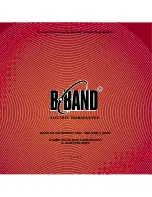
Safety Instructions
1. Read Instructions - All the safety and operating instructions
should be read before the equipment is operated.
2. Retain Instructions - The safety and operating instructions
should be retained for future reference.
3. Heed Warnings - All warnings on the equipment in the
operating instructions should be adhered to.
4. Follow Instructions - Follow all operating and user
instructions.
5. Water and Moisture - The equipment should not be used
near water; for example, near a bathtub, washbowl, kitchen sink,
laundry tub, in a wet basement, or near a swimming pool.
6. Mounting - The equipment should be mounted or secured as
recommended by the manufacturer.
7. Heat - The equipment should be situated away from heat
sources such as radiators, heat registers, stoves, or other equipment
(including amplifiers) that produce heat.
8. Power Sources - The product should be connected to a power
supply only of the type described in the operating instructions or
as marked on the equipment.
9. Grounding or Polarization - Precaution should be taken so
that the grounding or polarization means of the product is not
defeated.
10. Avoid spills and foreign objects. Ensure liquids and objects
don’t get into the product enclosure through any openings.
11. Damage Requiring Service - The equipment should be
serviced by qualified service personnel when: the power supply
cord or the plug has been damaged; objects have fallen, liquid has
been spilled into the equipment; the equipment has been exposed
to rain; the equipment does not appear to operate normally; or the
equipment has been dropped or the enclosure is damaged.
12. Servicing - The user should not attempt to service the
equipment beyond that described in the operating instructions. All
other servicing should be referred to qualified service personnel.
13. Care – From time to time you should wipe any dust
accumulation from the equipment with a soft dry cloth.
Note:
This equipment has been tested and found to comply
with the limits for a Class B digital device, pursuant to part 15 of
the FCC rules. These limits are designed to provide reasonable
protection against harmful interference in a residential
installation. This equipment generates, uses and can radiate radio
frequency energy and, if not installed and used in accordance
with the instructions, may cause harmful interference to radio
communications. However, there is no guarantee that interference
will not occur in a particular installation. If this equipment does
cause harmful interference to radio or television reception, which
can be determined by turning the equipment off and on, the
user is encouraged to try to correct the interference by one of or
more of the following measures: reorient or relocate the receiving
antenna; increase the separation between the equipment and
receiver; connect the equipment into an outlet on a circuit
different from that to which the receiver is connected, or consult
the dealer or an experienced radio/TV technician for help.
This Class B digital apparatus complies with Canadian ICES-003.
Cet appareil numérique de la classe B est conforme à la norme
NMB-003 du Canada.




























